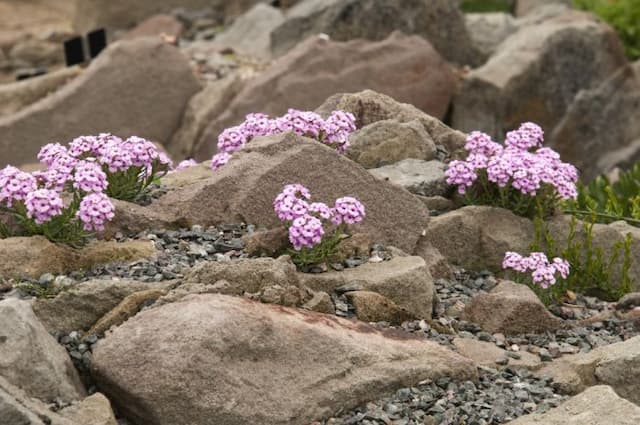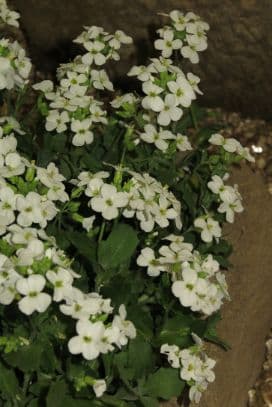Bowles's Mauve Wallflower Erysimum 'Bowles's Mauve'

ABOUT
Bowles's Mauve is a striking perennial wallflower that presents a profusion of richly colored flowers. Its blooms are a distinctive mauve hue, appearing as small, four-petaled blossoms densely packed together to form elongated clusters on the top of upright stems. These flower spikes lend a burst of color to the plant and can create an impressive display when several are in bloom simultaneously. The foliage of Bowles's Mauve is equally attractive. The leaves are narrow, elongated, and often have a grey-green to blue-green color, providing an excellent contrast to the vibrant mauve flowers. They form a bushy mound or a dense, evergreen clump that serves as a lush backdrop for the floral display. Throughout its flowering season, which can be quite long, Bowles's Mauve becomes a magnet for pollinators such as bees and butterflies, adding movement and life to the garden. This plant thrives in well-draining soil and favors a position where it can receive plenty of sunlight, making it a favorite among gardeners looking to add long-lasting color and texture to their landscapes.
About this plant
 Names
NamesFamily
Brassicaceae.
Synonyms
Bowles's Mauve Wallflower, Perennial Wallflower, Erysimum 'Bowles's Mauve'.
Common names
Erysimum 'Bowles's Mauve'
 Toxicity
ToxicityTo humans
Wallflower is generally not known to be toxic to humans. It is not listed among common poisonous plants and there should be no significant toxicity associated with Erysimum 'Bowles's Mauve' if ingested in small quantities. However, it's always prudent to avoid ingestion of ornamental plants as a general precaution. If large quantities are consumed, it could potentially cause mild stomach upset, but typically, it is not considered dangerous to humans.
To pets
Wallflower is not commonly known to be toxic to pets either. It is not typically listed among plants that are poisonous to cats, dogs, or other domestic animals. As a precaution, it is best to prevent pets from eating ornamental plants since they can still potentially cause mild gastrointestinal upset if ingested in large amounts, but wallflower is not expected to cause serious harm or significant poisoning symptoms.
 Characteristics
CharacteristicsLife cycle
Perennials
Foliage type
Evergreen
Color of leaves
Grey-green
Flower color
Mauve
Height
2 feet (0.6 meters)
Spread
2 feet (0.6 meters)
Plant type
Shrub
Hardiness zones
7
Native area
Mediterranean
Benefits
 General Benefits
General Benefits- Long flowering season: Erysimum 'Bowles's Mauve', or Wallflower, typically has a prolonged blooming period that can last from early spring to late summer.
- Attracts pollinators: The plant's vibrant flowers are known to attract butterflies, bees, and other beneficial pollinators to the garden.
- Low maintenance: This cultivar requires minimal upkeep once established and is relatively drought-tolerant.
- Colorful displays: Wallflower adds splashes of mauve and purple to gardens and landscapes, enhancing the visual appeal.
- Compact growth: Its neat, bushy growth habit makes it suitable for borders, rockeries, and containers.
- Evergreen foliage: In milder climates, Wallflower can retain its grey-green leaves year-round, providing consistent foliage.
- Easy to propagate: It can be easily propagated from cuttings, allowing gardeners to expand their planting without additional cost.
- Versatility: This plant is adaptable to a variety of garden styles, including cottage gardens and contemporary settings.
- Drought resistance: Once established, Wallflower can survive periods of low water availability, making it suitable for water-wise gardens.
 Medical Properties
Medical PropertiesThis plant is not used for medical purposes.
 Air-purifying Qualities
Air-purifying QualitiesThis plant is not specifically known for air purifying qualities.
 Other Uses
Other Uses- Erysimum 'Bowles's Mauve' can be used in floral arrangements, particularly for its long-lasting flowers and vibrant color that provides a striking accent in bouquets.
- This plant is suitable for butterfly gardens as it attracts a variety of pollinators, including butterflies and bees, supporting biodiversity.
- The dense foliage of Bowles's Mauve can serve as a natural mulch, when pruned and spread around plants, it helps to maintain soil moisture and suppress weeds.
- Bowles's Mauve can be planted to combat soil erosion on slopes due to its semi-woody growth habit and extensive root system.
- Use the plant to create a colorful, low-maintenance hedge in an informal garden setting, as it can be pruned to desired shapes and sizes.
- Its long blooming period makes it an excellent choice for educational gardens designed to teach about the lifecycle of plants and pollinator attraction strategies.
- When dried, the seed pods of Erysimum 'Bowles's Mauve' can add an interesting textural element to craft projects, such as creating natural wreaths or dried floral displays.
- The plant's resilience to coastal conditions makes it an ideal choice for seaside gardens, where it contributes to the overall foliage contrast and color.
- Bowles's Mauve can be planted among vegetable crops to help attract beneficial insects that can aid in pest control naturally.
- The plant can act as a colorful ground cover in sunny spots where turf grass might struggle to grow, providing color and interest throughout the growing season.
Interesting Facts
 Feng Shui
Feng ShuiThe Wallflower is not used in Feng Shui practice.
 Zodiac Sign Compitability
Zodiac Sign CompitabilityThe Wallflower is not used in astrology practice.
 Plant Symbolism
Plant Symbolism- Perseverance: Erysimum 'Bowles's Mauve', commonly known as Wallflower, often symbolizes perseverance due to its ability to thrive in poor soils and withstand challenging conditions.
- Faithfulness: Traditionally, wallflowers represent faithfulness in love, possibly due to their long blooming period, suggesting the enduring nature of true affection.
- Adversity: The wallflower's hardiness is often seen as a metaphor for enduring and overcoming adversity, much like the plant endures harsh growing conditions.
- Friendship: Their enduring presence in gardens has also led to wallflowers symbolizing lasting friendship, as they persist for many years once established.
- Humility: The wallflower's tendency to grow in the background, often against walls and in less noticeable spots, can symbolize humility and modesty.
 Water
WaterThe Wallflower should be watered thoroughly, allowing the water to penetrate deep into the root zone; typically, one to two gallons per week should suffice, depending on weather conditions and soil type. During the growing season, spring through fall, water the plant when the top inch of soil feels dry to the touch, which may be about once a week, reducing frequency during winter. Overwatering can lead to root rot, so ensure the plant has good drainage. During prolonged dry spells, supplemental watering may be necessary to keep the soil consistently moist but not waterlogged.
 Light
LightWallflowers thrive in full sun, so place them in a location where they can receive at least six hours of direct sunlight daily. They can tolerate partial shade, but flowering may be reduced. The ideal spot will be south or west-facing with ample light to encourage strong growth and plentiful blooms.
 Temperature
TemperatureWallflowers prefer moderate temperatures and can survive in a range from about 40 to 85 degrees Fahrenheit. They are hardy and can tolerate light frost, but prolonged exposure to temperatures below freezing may damage the plant. The ideal temperature range for Wallflowers is 60 to 72 degrees Fahrenheit to promote healthy growth.
 Pruning
PruningPrune Wallflowers to remove faded blooms and encourage bushier growth. During spring and summer, deadhead spent flowers regularly. Pruning can be performed after the main flowering period ends in early summer by cutting back the stems by a third to promote a second bloom in late summer or fall.
 Cleaning
CleaningAs needed
 Soil
SoilWallflower 'Bowles's Mauve' thrives in well-drained soil enhanced by organic matter, with a soil pH ranging from neutral to slightly alkaline (7.0-8.0). The best soil mix can be made by blending garden soil, compost, and grit or perlite to improve drainage.
 Repotting
RepottingWallflower 'Bowles's Mauve' typically does not require frequent repotting as it is a short-lived perennial. However, if necessary, it should be repotted every two to three years to refresh the soil and provide space for growth.
 Humidity & Misting
Humidity & MistingWallflower 'Bowles's Mauve' isn't particularly humidity-sensitive and can thrive in average garden conditions; thus, standard outdoor humidity levels are suitable.
 Suitable locations
Suitable locationsIndoor
Place in a sunny spot with well-draining soil.
Outdoor
Plant in well-drained soil, full sun.
Hardiness zone
7-9 USDA
 Life cycle
Life cycleBowles's Mauve, like many perennials, begins its life cycle when seeds germinate in spring or summer, given adequate moisture and favorable temperatures. The seedlings develop into rosettes of lance-shaped leaves, and as the plants mature, they produce strong woody stems with dense clusters of mauve flowers that bloom from early spring through summer, and sometimes into fall. After flowering, the plant sets seed, and these seeds can disperse to begin new plants. Over time, the woody stems can become leggy and the plant may require pruning to encourage bushier growth and more blooms. Bowles's Mauve is a short-lived perennial, typically lasting several years before needing replacement. If conditions are favorable, the plant may self-seed and perpetuate beyond the lifespan of an individual plant.
 Propogation
PropogationPropogation time
Early spring
The most popular method of propagation for the perennial plant known as Wallflower or Erysimum 'Bowles's Mauve' is through cuttings. This technique is typically performed during the late spring or early summer when the plant's growth is most vigorous. To propagate by cuttings, a gardener selects a healthy stem with good color and trims off a 3 to 4-inch (approximately 7.5 to 10 cm) section just below a leaf node. The lower leaves are removed, and the cut end is dipped into a rooting hormone powder to encourage root development. The prepared cutting is then placed in a well-draining soil mix and kept moist but not soggy. Ideal conditions include bright, indirect light and a consistent temperature of around 70 degrees Fahrenheit (approximately 21 degrees Celsius). With proper care, the cutting will develop roots and can be transplanted to a permanent location in the garden.



![Aubrieta [Axcent Light Blue]](/_next/image?url=https%3A%2F%2Fplants-admin.emdemapps.com%2Fimages%2Fplants%2F%2Fimages%2F604b5e7128866.png&w=640&q=75)





